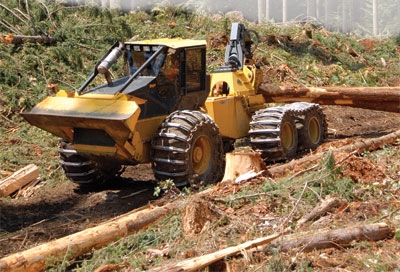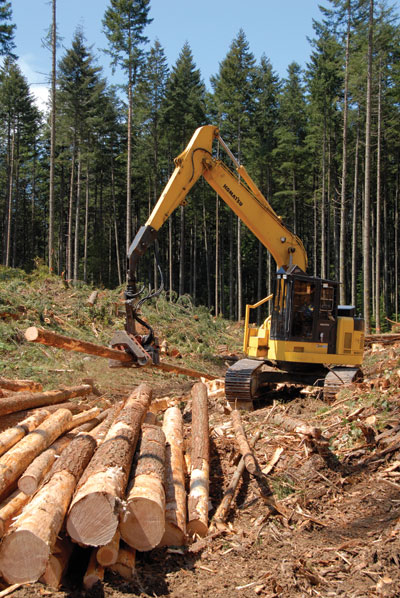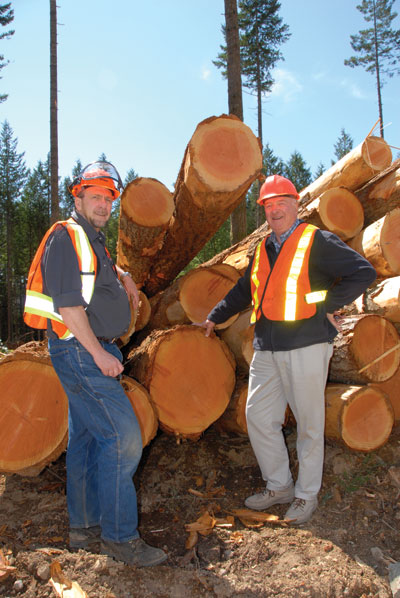
Features
Forestry Management
Harvesting
Balancing Act
Striking a balance between profitability, environmental considerations and local community needs and values is no easy task, but it’s a goal the staff and board of the Sunshine Coast Community Forest (SCCF) on British Columbia’s Lower Sunshine Coast have managed to meet. The three-year-old company is already in the black, which means any profits generated by the organization can now flow back to its sole shareholder, the District of Sechelt, which can in turn use the funds for community enhancement and other community projects.
November 14, 2011 By Bill Tice
 Striking a balance between profitability
Striking a balance between profitabilityLen Pakulak, former chairman of the board of the SCCF, which is officially called “Sechelt Community Projects Inc.,” says the idea for the community forest spawned from discussions between the past mayor of the District of Sechelt, Cameron Reid, and several other local residents, including Kevin Davie, who is now the operations manager for the company.
“Originally, the district mayor and others saw the need for a community forest and tried to bring other local jurisdictions here on the Sunshine Coast into the mix,” explains Pakulak. “When it became evident to the mayor and council that meeting the needs of several jurisdictions was going to be tough, the District of Sechelt decided to go alone in the venture, putting up $385,000 as a loan for the formation of the company.”
That initial cash infusion was in 2006 and in May of the same year, the SCCF, which “operates at arm’s length from the District,” was granted a Probationary Community Forest License from the B.C. Ministry of Forests for 20,000 cubic metres per year of timber over five years. The remainder of 2006 was spent on prep work, including block planning and layout, with the first harvesting activities taking place in 2007.
“In our first operational year, 2007, we harvested 28,000 cubic metres and it was a financial success for us,” says Davie. “We were able to pay back $250,000 of the original loan and provide our shareholder with a dividend.”
Another Positive Year
It was a similar story in 2008 with the SCCF paying off the balance of its loan and providing the District with another dividend payment. “By being debt free, we are now able to have more control over our financial future and that means we can do so much more for the community,” adds Davie. “We are hopeful that for 2009, we can make another dividend payment to the District and they will direct that money to local nonprofit organizations that need help.”
But for Davie and others involved in the SCCF, returning a profit to the District is only one aspect of helping the local area prosper. The organization has a policy of only supporting local business, which means the SCCF is creating employment on the Sunshine Coast by only hiring local contractors, suppliers and consultants, and buying supplies locally. “In addition and where possible, our first priority is selling the logs harvested from the area to companies on the Sunshine Coast for processing,” Davie says. “Our mandate from the District of Sechelt is to encourage economic development through expansion of the value added and secondary manufacturing industries.”
He estimates that in 2007 and 2008, the SCCF “pumped $3.6 million into the local economy,” and he adds that between the engineers, consultants, foresters and logging contractors they hire, the SCF currently creates the equivalent of seven indirect full-time jobs on the coast. That doesn’t include the two direct full-time jobs held by Davie and administrative assistant, Jacquie Cunliffe. “Right now we are running at a reduced volume due to the economic climate out there, but when times are better we could easily double our harvesting level and the number of jobs we create throughout the year,” notes Davie.
Flexibility Rules
As with most forest industry companies right now, dealing with the current downturn in demand has been challenging for the SCCF, but Davie says “flexibility” has been the key to the success they have achieved to date. “We have been able to create a balance by targeting specific products out of the forest rather than just logs for 2x4s,” he explains. “We are logging to meet special orders and not to build an inventory. That means we sell at market value and can create a balance between economics and the timber profile. We do have to maintain cash flow, but we are not about to go out and log the most valuable timber to make short-term gains.”
Davie points to Sunshine Coast-based West Coast Log Homes as an example of how they harvest to meet orders. “They may come to us and say ‘we need 145 logs for home construction’ and then they will go out into the forest with us and mark the trees they want. They are willing to pay a premium for being able to select specific trees, and we are able to sell to them at market value. There’s no deals or subsidies. In the past, loggers would ship the logs to a dryland sort where West Coast would go and pick out what they wanted and then have the logs shipped back to their manufacturing operation. Now, we deliver direct to their yard so everyone wins. On the last block we harvested, we had 10 local companies buy direct for everything from log home construction to fencing materials.”
Although Davie says they like to keep the logs in the local area, he acknowledges that it is a limited market and recognizes that they need to sell to other markets in order to remain profitable. With a large amount of fir in the fibre basket, peelers for the plywood and laminated veneer lumber markets account for a large part of the logs harvested by SCCF. Logs for use in timber frame housing and the piling and pole markets are also big sellers for the organization.
“We work with Canadian Overseas Log and Lumber out of Vancouver for a large percentage of our sales, both domestic and export,” notes Davie. “We chose to work with Canadian Overseas because they have experience selling for other community forests, and they have the ability to find niche markets, which is really important to us and our bottom line.”
Pakulak is also complimentary towards the log brokerage firm. “We have built our business on strong relationships and Canadian Overseas has gone out of their way to help us in a number of areas. They have been highly supportive of what we are trying to achieve and that sure helps when you are getting started.”
Flexibility comes up again when Davie talks about working with Canadian Overseas for orders shipped off the Sunshine Coast, especially when it comes to planning and harvesting activities. “Because we are normally harvesting to meet specific orders secured by Canadian Overseas, we are able to look at a number of factors when making the decision on where, when and how to log,” he says. “We have the capability to use both mechanized harvesting and hand felling so we can look at what the end customer needs, analyze potential blocks, find out what the engineers and the foresters are telling us about soil conditions and reforestation options, and then make an informed decision based on all of these factors.”
Good Value Payoff
Davie was happy to show two very different blocks to illustrate his point. The first block was in the process of being actively harvested. “For this block, we wanted to leave some trees and we didn’t want the trees left standing to sustain any damage so we decided to use mechanized harvesting,” he explains while walking down a logging road with sorted logs piled up at roadside. “We go through this decision-making process on all of the blocks we harvest and we have enough systems available to us that we can make sure we utilize best practices at all times. That might mean hand felling, thinning or mechanized harvesting, or in the future, it could mean using a cable system or helicopter logging.”

A harvested block, Davie calls “a silviculture slum” is another area he likes to showcase. “This is a block of suppressed hemlock and fir and we are harvesting it and re-establishing a healthy stand because it was poorly managed in the past,” he explains. “When we get good value from a well-managed higher value block like the first one we looked at, we are able to balance that off with a block such as this one and still remain profitable.”
It’s not just Davie and his foresters and engineers that give the SCCF high marks for its forest management techniques. The organization is required to have a Forest Investment Account (FIA) audit on a regular basis and in the latest visit from the independent auditors at Pricewaterhouse Coopers (PwC), the SCCF received 100% compliance for its FIA activities. “The people from PwC were diligent and they found that we were doing everything right, from record keeping and accounting to what we are doing in the field,” Davie says.
In addition to answering to the auditors, Davie says they have a “very supportive” volunteer board of directors and Community Forest Advisory Committee that they also must work with closely. “Our Board of Directors and our Advisory Committee members are all volunteers and they all live in this area so they have a stake in what we do. Our advisory board meets monthly and we go to them often for input in our plans. We actually call our plan a ‘Community Forest Operating Plan’ and it covers much more than just harvesting. It is available on our website for anyone who wants to see it.”
The Right Contractors
Davie also attributes much of their success to choosing the right contractors for each job. “We have a number of very good contractors here on the coast and they all have their individual strengths,” he says. “When we are looking at our harvesting plans, we go out to tender and have the contractors submit sealed packages, which we open with SCCF directors on hand. The bids are analyzed based on a number of factors such as the contractor’s past track record, the equipment they have available to them, and their experience. Of course, we have to look at cost as well, but that is not the main factor in our decision. I want the best bid overall, which isn’t necessarily the cheapest.”
Another key area of interest for the SCCF is education as Davie says they want to share what they are doing with the public. “We need to educate people about forest health, sustainability, water management and other key areas of responsible forestry,” he says. “In addition to educating the general public, we also need to reach the school kids. We participate in teacher education programs, we are part of the Festival of Forestry, and we have spent a lot of time this year giving seedlings to every elementary school student on the Sunshine Coast.”

Looking into the future, Davie and Pakulak only see growth for the SCCF. Now that they are operating at a positive cash flow situation, they are looking for ways to expand the economic development of the wood products manufacturing industry on the Sunshine Coast, meaning more of the logs harvested by the SCCF can be processed locally. Davie sees an upcoming one-day wood forum on Oct. 5 in Sechelt as the next opportunity. “We are bringing together local developers, construction contractors, value added producers, local government and investors,” he says. “We want to see what markets are out there and create some synergies for everyone involved in value added wood products on the Sunshine Coast. To be successful, we need to work together and create a business plan that works for everyone from the logging contractors to the wood products manufacturers and local businesses. In the end, we will all benefit.”
Print this page